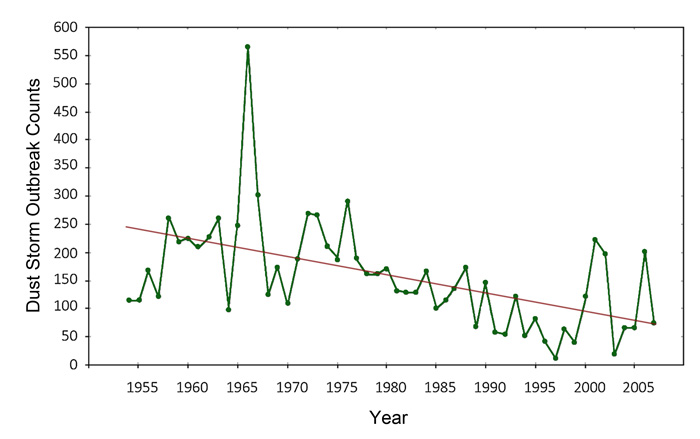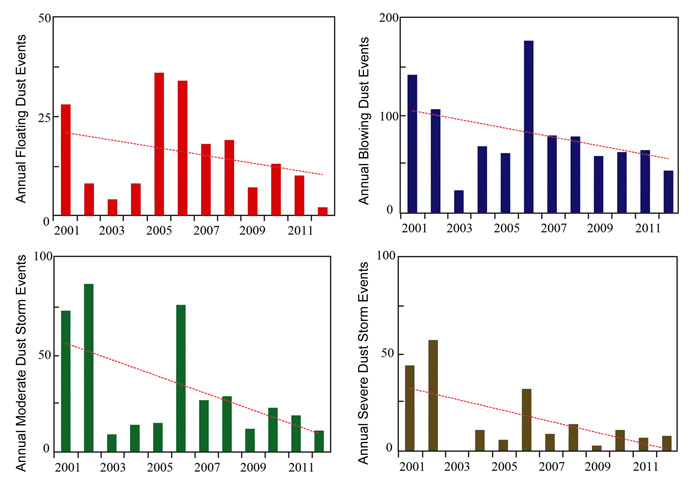| Tweet | Follow @co2science |
Paper Reviewed
Li, N., Guo, L. and Fan, B. 2015. A new perspective on understanding the reduced spring dust storm frequency in Inner Mongolia, China. International Journal of Disaster Risk Science 6: 216-225.
Introducing their study, Li et al. (2015) write that "dust storms occur in association with strong turbulent winds and exposed soil surfaces (Goudie, 1983, 2009) and have wide-ranging implications for the natural system and human society," further noting that East Asia has large areas of arid and semi-arid lands that "are some of the strongest source areas for dust storms and pose annual dust storm threats," citing Goudie and Middleton (1992) and Liu et al. (2011). In addition, they remind us that "dust storms also exert strong impacts on local and global climate by modifying radiative forcing, cloud physical properties, and biogeochemical cycling," citing Idso (1974) and Creamean et al. (2013). Consequently, they took it upon themselves to study the temporal dynamics of spring dust storms in Inner Mongolia, which is a major dust source area in East Asia. And what did they thereby learn?
The three Chinese scientists determined that (1) "severe spring dust storms have significantly declined from 1954 to 2007" (see Figure 1 below), that (2) "four dust storm types showed similar decreasing trends from 2001 to 2012" (see Figure 2 below), that (3) this change in spring dust storm dynamics is due to "the shift in vegetation green-up dates based on the analysis of a satellite derived vegetation index," that (4) "earlier vegetation green-up has a dampening effect on spring dust storms," and that (5) "suitable environmental conditions for vegetation green-up hinder the emergence of dust storms."
Also, in this regard, we note that several scientific studies - Xu et al. (2012), Zhao et al. (2012), Zhou et al. (2014) and Piao et al. (2015) - have determined that the enhanced green-up of Chinese arid and semi-arid lands has been predominantly due to the concomitant CO2-induced greening of the earth, which human-induced phenomenon now has another significant benefit to add to its several beneficent consequences.

Figure 1. Annual severe regional spring (February-June) dust storms counts in central Inner Mongolia from 1954 to 2007 based on field observations from 23 ground stations. The red line indicates the linear decreasing trend in the data. Adapted from Li et al. (2015).

Figure 2. Temporal dynamics and trends of different types of spring (February-June) dust storms in central Inner Mongolia from 2001 to 2012. Dust storm data are from the SYNOP (surface synoptic observations) reports from 23 ground stations. Histograms indicate the annual counts of spring dust storms for floating dust events (red bars, top left), blowing sand events (blue bars, top right), moderate dust storm events (green bars, bottom left) and severe dust storm events (brown bars, bottom right). Dashed red lines indicate linear trends in the data. Adapted from Li et al. (2015).
References
Creamean, J.M., Suski, K.J., Rosenfeld, D., Cazorla, A., DeMott, P.J., Sullivan, R.C., White, A.B., Ralph, F.M., Minnis, P., Comstock, J.M., Tomlinson, J.M. and Prather, K.A. 2013. Dust and biological aerosols from the Sahara and Asia influence precipitation in the western U.S. Science 339: 1572-1578.
Goudie, A.S. 1983. Dust storms in space and time. Progress in Physical Geography 7: 502-530.
Goudie, A.S. 2009. Dust storms: Recent developments. Journal of Environmental Management 90: 89-94.
Goudie, A.S. and Middleton, N.J. 1992. The changing frequency of dust storms through time. Climatic Change 20: 197-225.
Idso, S.B. 1974. Thermal blanketing: A case for aerosol-induced climatic alteration. Science 186: 50-51.
Liu, L.Y., Shi, P.J., Hu, X., Liu, T.K., Guo, L.L., Zhang, X.X., Tang, Y., Lv, Y.L. et al. 2011. Natural factors influencing blown sand hazards in Beijing. International Journal of Disaster Risk Science 2: 23-31.
Piao, S, Yin, G., Tan, J., Cheng, L., Huang, M., Li, Y., Liu, R., Mao, J., Myneni, R.B., Peng, S., Poulter, B., Shi, X., Xiao, Z., Zeng, N., Zeng, Z. and Wang, Y. 2015. Detection and attribution of vegetation greening trend in China over the last 30 years. Global Change Biology 21: 1601-1609.
Xu, X., Piao, S., Wang, X., Chen, A., Ciais, P. and Myneni, R.B. 2012. Spatio-temporal patterns of the area experiencing negative vegetation growth anomalies in China over the last three decades. Environmental Research Letters 7: 10.1088/1748-9326/7/3/035701.
Zhao, X., Zhou, D. and Fang, J. 2012. Satellite-based studies on large-scale vegetation changes in China. Journal of Integrative Plant Biology 54: 713-728.
Zhou, W., Gang, C., Chen, Y., Mu,S., Sun, Z. and Li, J. 2014. Grassland coverage inter-annual variation and its coupling relation with hydrothermal factors in China during 1982-2010. Journal of Geographical Sciences 24: 593-611.
Posted 5 February 2016



